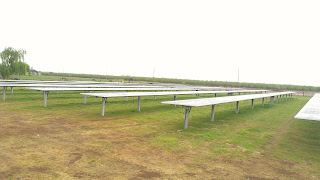 I am humbled to announce that since 2009, my small family and employee-owned company, Pristine Sun, has achieved energized solar systems (construction fully completed with systems operational) growth of 496% CAGR (Compound Annual Growth Rate, measured in growth year over year) since 2009.
I am humbled to announce that since 2009, my small family and employee-owned company, Pristine Sun, has achieved energized solar systems (construction fully completed with systems operational) growth of 496% CAGR (Compound Annual Growth Rate, measured in growth year over year) since 2009.The kilowatts energized by 12/31/2012 (nearly all on commercial and industrial rooftops and carport shade structures) are enough to power the equivalent of 510 average homes (assuming 5 kWp per home of capacity, which generates about 750 kWh per month on average). We currently own and operate 55 solar PV systems in the state of New York, one in Arizona, and 10 in California. These are all "behind the meter" systems, where the energy is delivered to the building owner or tenant and lowers their electric bill by an average of 15% or more in the first year.
Each of our customers signs a 20-year solar service agreement containing a fixed price per kWh in the first year with a very low to modest annual price escalator (usually around 2-3%). This means that their bill will remain lower than the local utility rates, and the savings will increase over time, often significantly (depending on how fast utility bills continue to increase). Assuming average electricity prices increase by 5%+ per year (historical averages are actually closer to 6-7% even with lower natural gas prices, since only 1/3 of an electric bill is generation and 2/3 is transmission & distribution), our customers will see savings of up to 50% compared to their neighbors after a number of years. Some of our customers are already re-investing their electricity bill savings into energy efficiency upgrades and EV chargers for their cars & trucks (yes, there are 100% electric and plug-in-electric trucks as well) to save even more and accelerate their energy independence.
Remember that solar modules have 25-year performance output guarantees and have consistently out-performed their warranties for over five decades now, and the expected life of the modules is 35-50 years. Plus, because we're lowering the cost of operating the building, studies show that our solar systems increase the building and property value by about $15 to $25 for every $1 in annual energy savings. Since the fuel cost to operate a solar system is free, we are very excited to be helping to stimulate our economy by making our customers more financially stable and productive for decades to come. Not to mention the vast savings of avoiding the healthcare and climate change costs by not burning as many fossil fuels.
In 2013, I'm pleased to announce that my company has begun construction (finally) on our fleet of utility scale small solar power plants (or solar farms or solar parks, if you will). Nearly all of these projects are located in rural California on land that is not suitable for farming, such as grazing land or fallow land. Despite that, we've also gone above and beyond to make them as sustainable as possible: we are planting native wildflowers to support local bee apiaries and in some cases allowing sheep ranchers to graze their sheep between the rows of solar modules. This maximizes the use of the land and provides in some cases additional revenue to the landowner (usually a small family farmstead).
It appears likely that we will construct over 25 MW (megawatts), or 25 million watts, of such projects this year, in addition to continued growth of our rooftop commercial projects. This is of course conditional upon closing continued construction financing and post-construction take-out loans for these projects. 25 MW, on top of the 2.5 MW we've already installed through 2012, is equivalent to powering a whopping 5,000 American homes!
Assuming we energize (Star Trek, anyone?) 25 MW this year, our CAGR will continue to equal about 500% from 2009 through 2013. However, beginning in 2014 it will be quite difficult to increase by five times the growth (that's 125 MW next year) due to our increasing size & scale. We'll do our best to raise the sufficient construction and post-construction financing necessary, however, because project finance is the only factor that constrains our growth. We have a nearly unlimited supply of small utility scale solar projects and small rooftop commercial projects we could build, thanks to our amazing network of installers and sales consultants.
Here is a photo of one of our small (325 kW) utility scale solar PV systems going online on 3 acres in Tehama County California (north of Sacramento):
Check back for more updates later, and thanks for reading!
Cheers,
Troy

No comments:
Post a Comment